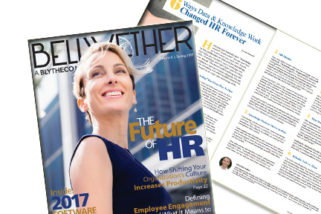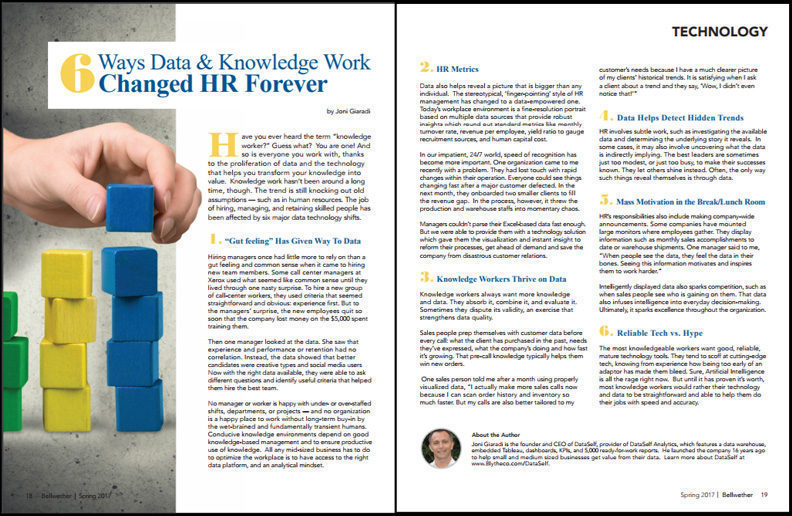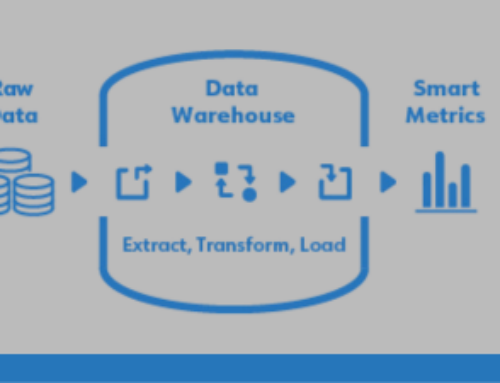 Have you ever heard the term “knowledge worker?” Guess what? You are one! And
Have you ever heard the term “knowledge worker?” Guess what? You are one! And
so is everyone you work with, thanks to the proliferation of data and the technology
that helps you transform your knowledge into value. Knowledge work hasn’t been around a long time, though. The trend is still knocking out old assumptions — such as in human resources. The job of hiring, managing, and retaining skilled people has
been affected by six major data technology shifts.
1. “Gut feeling” Has Given Way To Data Hiring managers once had little more to rely on than a gut feeling and common sense when it came to hiring new team members. Some call center managers at Xerox used what seemed like common sense until they lived through one nasty surprise. To hire a new group of call-center workers, they used criteria that seemed straightforward and obvious: experience first. But to the managers’ surprise, the new employees quit so soon that the company lost money on the $5,000 spent training them. Then one manager looked at the data. She saw that experience and performance or retention had no correlation. Instead, the data showed that better candidates were creative types and social media users Now with the right data available, they were able to ask different questions and identify useful criteria that helped them hire the best team. No manager or worker is happy with under- or over-staffed shifts, departments, or projects — and no organization is a happy place to work without long-term buy-in by the wet-brained and fundamentally transient humans. Conducive knowledge environments depend on good knowledge-based management and to ensure productive use of knowledge. All any mid-sized business has to do to optimize the workplace is to have access to the right data platform, and an analytical mindset.
2. HR Metrics Data also helps reveal a picture that is bigger than any individual. The stereotypical, ‘finger-pointing’ style of HR management has changed to a data-empowered one. Today’s workplace environment is a fine-resolution portrait based on multiple data sources that provide robust insights which round out standard metrics like monthly turnover rate, revenue per employee, yield ratio to gauge recruitment sources, and human capital cost. In our impatient, 24/7 world, speed of recognition has become more important. One organization came to me recently with a problem. They had lost touch with rapid changes within their operation. Everyone could see things changing fast after a major customer defected. In the next month, they onboarded two smaller clients to fill the revenue gap. In the process, however, it threw the production and warehouse staffs into momentary chaos. Managers couldn’t parse their Excel-based data fast enough. But we were able to provide them with a technology solution which gave them the visualization and instant insight to reform their processes, get ahead of demand and save the company from disastrous customer relations.
3. Knowledge Workers Thrive on Data Knowledge workers always want more knowledge and data. They absorb it, combine it, and evaluate it. Sometimes they dispute its validity, an exercise that strengthens data quality. Sales people prep themselves with customer data before every call: what the client has purchased in the past, needs they’ve expressed, what the company’s doing and how fast it’s growing. That pre-call knowledge typically helps them win new orders. One sales person told me after a month using properly visualized data, “I actually make more sales calls now because I can scan order history and inventory so much faster. But my calls are also better tailored to my customer’s needs because I have a much clearer picture of my clients’ historical trends. It is satisfying when I ask a client about a trend and they say, ‘Wow, I didn’t even notice that!’”
4. Data Helps Detect Hidden Trends HR involves subtle work, such as investigating the available data and determining the underlying story it reveals. In some cases, it may also involve uncovering what the data is indirectly implying. The best leaders are sometimes just too modest, or just too busy, to make their successes known. They let others shine instead. Often, the only way such things reveal themselves is through data.
5. Mass Motivation in the Break/Lunch Room HR’s responsibilities also include making company-wide announcements. Some companies have mounted large monitors where employees gather. They display information such as monthly sales accomplishments to date or warehouse shipments. One manager said to me, “When people see the data, they feel the data in their bones. Seeing this information motivates and inspires them to work harder.” Intelligently displayed data also sparks competition, such as when sales people see who is gaining on them. That data also infuses intelligence into everyday decision-making. Ultimately, it sparks excellence throughout the organization.
6. Reliable Tech vs. Hype The most knowledgeable workers want good, reliable, mature technology tools. They tend to scoff at cutting-edge tech, knowing from experience how being too early of an adaptor has made them bleed. Sure, Artificial Intelligence is all the rage right now. But until it has proven it’s worth, most knowledge workers would rather their technology and data to be straightforward and able to help them do their jobs with speed and accuracy.





